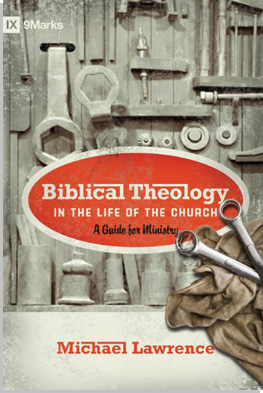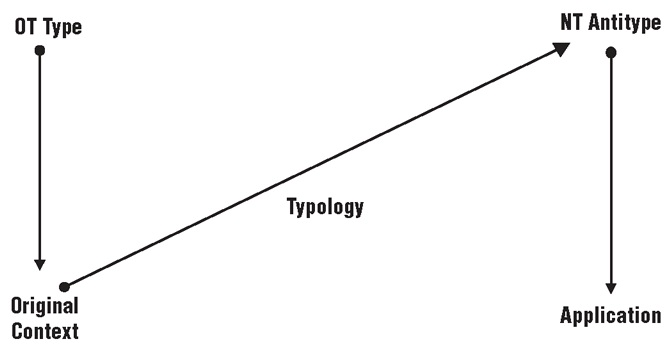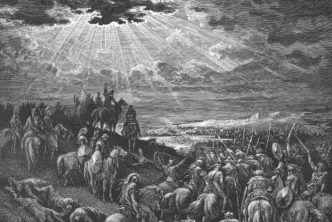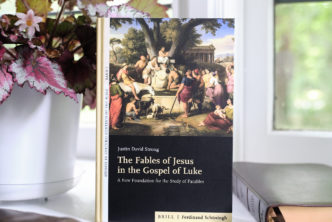How do you use your Bible?
 That is the question Michael Lawrence opens with in his 2010 book Biblical Theology in the Life of the Church. He expands on that question, explaining that how we use it illuminates how we think about it. Do we see it as an instruction manual or as a cohesive, divine story? Lawrence suggests not only that the church needs a better working definition of the Bible, but that biblical theology will help inform that definition.
That is the question Michael Lawrence opens with in his 2010 book Biblical Theology in the Life of the Church. He expands on that question, explaining that how we use it illuminates how we think about it. Do we see it as an instruction manual or as a cohesive, divine story? Lawrence suggests not only that the church needs a better working definition of the Bible, but that biblical theology will help inform that definition.
Biblical theology helps us establish that better understanding of what the Bible is. When we talk about biblical theology, we mean a theology that not only tries to systematically understand what the Bible teaches, but to do so in the context of the Bible’s own progressively revealed and progressively developing storyline. Faithful biblical theology attempts to demonstrate what systematic theology assumes: that the Scriptures are not an eclectic, chaotic, and seemingly contradictory collection of religious writings, but rather a single story, a unified narrative that conveys a coherent and consistent message. Thus biblical theology is concerned not just with the moral of the story, but the telling of the story, and how the very nature of its telling, its unfolding, shapes our understanding of its point.
The tools of exegesis
After determining the importance of biblical theology in this way, he moves into discussing several of the tools we use to do biblical theology in a faithful and reliable way. The first of these exegetical tools is the grammatical-historical method. Exegesis is concerned with a correct reading of the text, and to that end Lawrence tackles the question of whether or not a text can have an absolute meaning. He affirms that texts do in fact have concrete truths intended, he says, “precisely because God, who created this world, our brains, and thus our ability to use language, is himself a speaking God. It was God,” he continues, “who created rationality and language so that language could accurately convey meaning from one mind to another mind. And he himself proved this not only by acting in history, but also by condescending to use human language to authoritatively explain and interpret his own actions.”
Lawrence continues discussing the grammatical-historical method, asserting that the basic unit of meaning is found at the sentence-level, which pushes us to look in its discourse context. To expand the context that we look at, we must also incorporate historical questions of background, geography, and more. Of course not everyone will know the answers to the questions this will raise off the top of their heads, but here we find help in concordances, dictionaries, encyclopedias, and the other tools available to us.
After discussing the grammatical-historical method, he moves into the topic of literary forms. Every biblical passage falls into a specific genre, and unless we know how to read that genre we will not be able to accurately interpret that passage. Lawrence gives the reader practical tools and methods for interpreting the major genres of scripture, including narrative, parable, poetry, wisdom, prophecy, epistles, and apocalyptic literature. Lay readers will want to bookmark or note these pages (pages 45–51) for future reference, as the list of genre-specific distinctives is remarkably useful.
The tools of biblical theology
With the exegetical tools examined, Lawrence then introduces six indispensable tools for biblical theology. These tools are a thorough understanding of covenant, epochs, canon, prophecy, typology, and continuity/discontinuity. Of these, perhaps the typology is the most fascinating and helpful, which warrants a more in-depth look.
Lawrence first discusses what typology is, and what it isn’t. He is quick to draw a firm and helpful difference between arbitrary symbolism or allegory and typology. A type is “an actual historical person or event that God has providentially ordered in order to use that person or event to point beyond himself or herself” to its eventual antitype. Similar to multi-horizon prophecy fulfillment (discussed by Lawrence in some depth earlier in the book), types often have multiple instances, all together pointing to the ultimate antitype. A great example of this is found in Hebrews, where the author uses many types, such as Melchizedek, the Old Testament sacrificial system, and the priestly order—all to point to one final antitype: Jesus.
One of the areas where rubber meets road in this book is the application of these principles to ministry. The discussion on typology is a great example of that, as Lawrence shows how a robust understanding of typology can help us avoid moralism and allegory when trying to apply Old Testament passages. Instead of moving from the type straight into application, he walks through how we ought to trace the type in its original context to its antitype, and only then to application. This is the difference between David and Goliath as story about being brave for God and understanding Christ through typology “as our anointed but veiled king, a mediator who delivers God’s people through individual mortal combat with our greatest enemy. The primary point of application thus moves from moral effort on our part to worship and faith in Christ our champion!”

Lawrence recognizes that for solid biblical interpretation and application, we need more than biblical theology: systematic theology is needed as well. Even though this is a book on biblical theology, he devotes two entire chapters to discussing the relationship between systematic and biblical theology, and how and why we do systemic theology. These chapters are immensely helpful for understanding when to lean on which field of study, and what the purposes would be. He suggests that biblical theology envelops us into the biblical story, helping us to understand it within its own context. Systematic theology, on the other hand, takes what is learned from biblical theology and synthesizes it for use in our context, informing our worldview. One really cannot thrive without the other.
Study and ministry application
The entirety of what we’ve discussed above is just the first of three sections, and it’s not even scratching the surface. In Section two, Lawrence switches gears from putting tools in the toolbox, to actually building something. He examines five biblical story arcs—creation, the fall, love, sacrifice, and promise—using the exegetical and biblical theology tools learned in the first five chapters to interpret and apply the stories. This is an incredibly applicable section. With major themes traced and applications teased out, each one of these stories could be used as a small group study or as family devotions.
In the third section, Lawrence helps us put it all together for the church. After all, the book is subtitled A Guide for Ministry, and he certainly helps move us from getting equipped to studying and applying personally and finally to the last step of preaching and teaching it. This section has helpful case studies and examples, as well as a thorough application grid you can even copy out and use in your own sermon or lesson preparation. I could write pages on both of these last sections, but trust me when I say that it will be worth your time to read it yourself!
Conclusion
At my local church, we consider it part of the Elders’ ministry to give away and recommend books, and this is a book that I would not hesitate to hand nearly anyone in the congregation. In fact several of the Elders have given this book to various members in the past, and one of them reported back to me saying “this is the most important book I have ever read.” And I can see why! Biblical Theology in the Life of the Church comes at a crucial time, when society is demanding that we critically engage what we believe, yet few are taught the methods or given the tools needed to do just that. This book fills a gap, and it will be appreciated by pastors, laymen, students, and ministry leaders everywhere.
Free in the month of February
We are pleased to be working with Crossway and 9Marks to give this book away free all during the month of February. In Logos, this book becomes even more useful. Follow the links in the footnotes to explore the sources that influenced Lawrence, look up terms and concepts with a click, take notes, and share passages that have encouraged you through Faithlife. It also plugs into your existing tools and features, adding its information to your search results, making the software even more useful.
Don’t miss this chance to grab a remarkable book from Michael Lawrence—head over to Logos’ Free Book of the Month page and grab it today. And don’t forget to enter for your chance to win the 11-volume 9Marks Series!
What others are saying
Following in the footsteps of Geerhardus Vos and Edmund Clowney, Michael Lawrence has provided us with a masterly study that relates biblical theology to systematics, and then applies both to the ministry of the church. This skillfully executed integrative approach breaks new ground in the practical application of biblical theology.
—Graeme Goldsworthy
While there are many treasures in this book, its primary richness comes from following the flow of redemptive history five times over—each time from a different perspective, built around a different theme. Looking at biblical theology like one stone with many facets was an exceptionally enlightening approach. This is a book to be read and reread.
—John MacArthur
Michael Lawrence believes that good shepherds are theologians and good theologians are shepherds. For anyone who believes that theology needs the church and the church needs theology, this will be a welcome resource. For anyone playing with the idea, it will be a compelling one.
—Michael Horton




